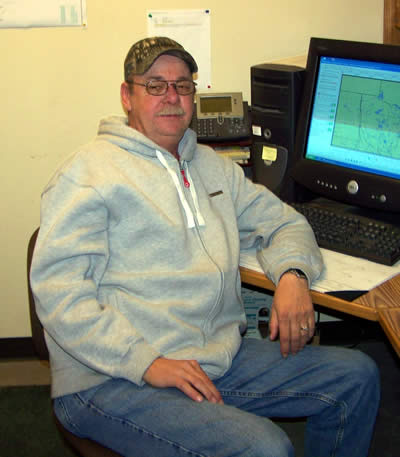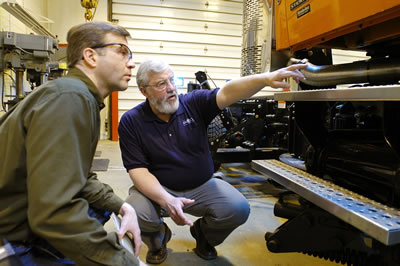|
By Craig Wilkins

Until he recovers fully, Tom Puppe works in District 2’s Thief River Falls bridge office providing support for Bemidji’s automated Maintenance Decision Support System and other initiatives. Photo by Steve Hufnagle |
One year ago, Tom Puppe’s life changed in a searing, agonizing moment.
Puppe, a bridge worker with Bemidji/District 2, suffered a compound ankle fracture March 27, 2007 when he slipped while repairing the Hwy 11 bridge between Drayton, N.D., and Robbin, Minn.
He was hurt when the large crescent wrench he was using slipped off a bridge bolt and caused him to fall onto an aerial lift platform.
But fewer than two months after his surgery, Puppe was back at work part-time, lending his knowledge and field experience to the staff at the district’s bridge office in Thief River Falls .
Safety Administrator Rod Starkey filed Puppe’s workers compensation claim, worked with his doctor to approve an early return to work and found a rehabilitation coordinator to support his recovery.
Starkey also worked with Roger Hille, district bridge and operations engineer, to find meaningful work for Puppe.
Puppe’s quick return to work is a district hallmark—getting injured employees to do meaningful work, helping them stay in contact with co-workers, learning new skills while reducing workers compensation and medical costs.
The district reduced its workers compensation costs and lost time hours last year. Other districts and the Central Office, however, either stayed about the same or increased compared with 2006.
New safety committee will lead, set policy

Todd Haglin, Mn/DOT’s safety director (at left) reviews safety procedures at the Central Shop with John Scharffbillig, fleet supervisor, Office of Maintenance. Photo by David Gonzalez |
Deb Ledvina, Risk Management Unit director, said the plans of Mn/DOT’s new Departmentwide Safety Committee implement District 2’s successes and other safety best practices statewide as part of the department’s rejuvenated safety program.
Formation of the new safety panel follows Todd Haglin’s appointment as the agency’s safety director.
Since taking his new post, Haglin has worked with district safety officials and managers to standardize safety programs, reporting systems and training as well as chart the new committee’s goals and priorities.
Ledvina said a comprehensive audit conducted last year shows the department needs a coordinated, performance-based safety program in order to decrease injuries, lost time and workers compensations costs.
During fiscal year 2007, she said, workers compensation costs soared nearly $1 million compared with the 2006 fiscal year, reaching nearly $4.4 million.
Medical fees increased by 60 percent and were a major factor in rising workers compensation costs, she said.
Focus shifts to accountability
Ledvina said prevention and accountability will play larger roles than previously to reduce accidents and injuries.
“We will make several visits to district offices and shops this year to meet with staff and underscore our increased commitment to safety,” she said.
Accident review boards established
Accident review boards will be established in each district. The boards will examine all motor vehicle-related accidents and determine whether or not the incidents were preventable.
When injuries occur, Ledvina said, “We’ll keep our focus on supporting the individual employee with early post-injury involvement, rehabilitation and coaching to set goals for the employee’s return to their regular job assignments.”
Ledvina said, however, the principal goal remains preventing accidents.
“With a coordinated approach, clear accountability and performance-based results, we expect to improve employees’ safety and reduce injury-causing accidents that are costly to the individual, the work unit and Mn/DOT’s overall goals,” she said.
New safety committee will seek to instill ‘culture of safety’
Mn/DOT’s Departmentwide Safety Committee will explore its charter and its objectives during the panel’s first meeting March 28 in St. Paul.
Todd Haglin, safety director, said the committee’s charges includes ensuring that safety goals and performance measures are met and that safety initiatives will be carried out in a uniform manner throughout the agency.
The committee will include 12 representatives from all divisions plus the chair. The chair is the Operations Division director, currently Bob Winter.
Haglin will be a non-voting member and serve as staff for the committee.
District 2 rewards avoiding backing incidents with praise, pizza
Don’t back up.
That’s one sure way to reduce the number of vehicle crashes and other incidents caused by backing.
Backing mishaps can cause serious property damage and, of course, severe injury or death.
District 2’s Rod Starkey initiated the backing safety program after the district recorded 12 backing-related incidents in 1995.
The number of incidents fell to one in 2006 but bounced back to five in 2007. That spike, he said, serves as a stern reminder to keep a strong focus on backing safety.
“We encourage employees to avoid backing whenever possible, whether they’re in a parking lot or a project out on the road,” Starkey said.
The program, known as “Target Zero,” consists of four components: promotion, training, measurement and incident review.
“The recognition part has been the biggest hit among employees,” he said.
“Every six months that a work unit goes without a backing accident, we serve the employees pizza during one of their safety training sessions,” Starkey said. |
|



